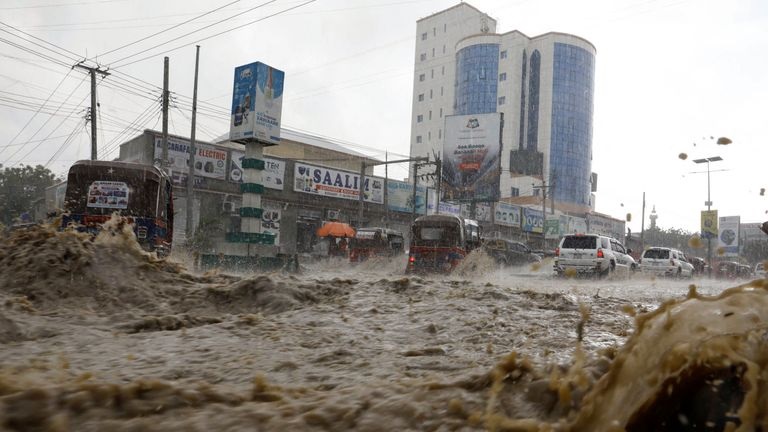More than 1.6 million people in Somalia could be affected by the recent unusually heavy seasonal rains, the United Nations has warned.
The UN has released $25m (£20.5m) in aid, describing the floods as a “once-in-a-century event.”
Authorities say at least 29 people have been killed and more than 300,000 displaced, with more rain to come.
Somalia and neighbouring countries in East Africa have been hit by heavy rains since early October.
The UN Office for the Coordination of Humanitarian Affairs (OCHA) said the downpours had been worsened by the combined impact of two climate phenomena – El Niño and the more localised Indian Ocean Dipole, referring to differences in sea surface temperature in opposite parts of the ocean.
The agency warned that some 1.5 million hectares (3.7 million acres) of farmland could potentially be destroyed.
Martin Griffiths, the UN’s Humanitarian Affairs and Emergency Relief coordinator, said: “Extreme weather linked to the ongoing El Niño risks further driving up humanitarian needs in already-vulnerable communities in Somalia and many other places.”
“We know what the risks are, and we need to get ahead of these looming crises.”
The UN humanitarian agency said rescue efforts were being delayed because roads had been cut.
Aid groups have also warned that camps for people displaced by an Islamist insurgency and the recent drought had also been flooded, causing people to flee for a second time.
OCHA warned on Wednesday that more rain is expected in the coming days, and that the forecast shows very heavy to extremely heavy rainfall is expected in southern Somalia.
Somalia is considered one of the most vulnerable countries to climate change, and the country is experiencing heavier than normal rains after emerging from one of its worst droughts in four decades.
The flooding began last month after heavy rains raised water levels and caused the overflowing of the Juba and Shabelle rivers.
Flash floods have also killed dozens of people in neighbouring Kenya and Ethiopia.
Earlier this week, Somalia declared an emergency in the most-affected states – Jubbaland, Hirshabelle South West and Galmudug.
OCHA said in September that East Africa was likely to encounter heavier than normal rains over the October-December period because of the El Niño phenomenon.
El Niño is caused by the Pacific Ocean warming and is linked to flooding, cyclones, drought, and wildfires.
Many factors contribute to flooding, but a warming atmosphere caused by climate change makes extreme rainfall more likely.
BBC.

